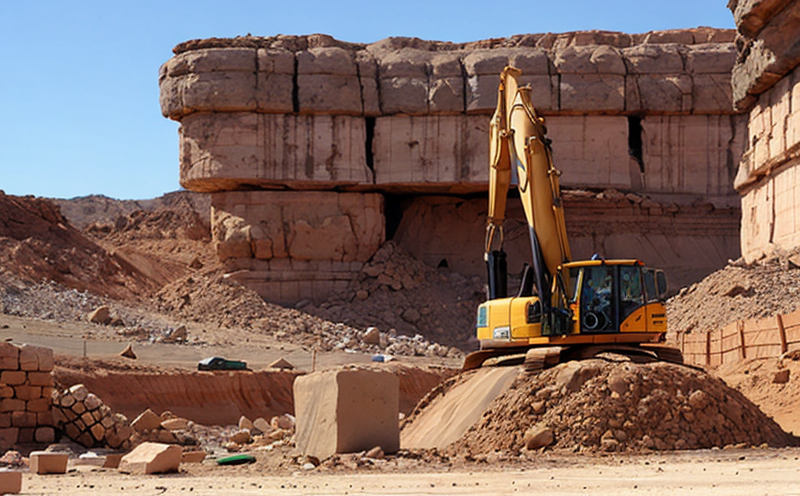ISO 14689 Rock Mass Characterization Testing
The ISO 14689 standard for rock mass characterization is a comprehensive framework designed to assess the engineering properties of rock masses. This testing method is essential in mining and geotechnical applications where understanding the structural behavior under stress is critical for safety, design, and operational efficiency.
Rock mass characterization involves evaluating not only individual rock samples but also the overall structure of the rock formation. This approach recognizes that rocks do not behave as homogeneous materials; rather, they are composed of a matrix of rock blocks connected by weaker interfaces known as joints or bedding planes. The integrity of these rock masses is crucial in mining operations, where the stability and strength of the rock can significantly influence excavation safety.
The testing process typically involves several stages, including site investigation, sample collection, sample preparation, and finally, the application of standardized tests to determine the mechanical properties of the rock mass. This includes shear strength, tensile strength, and elastic modulus among others. The results are used in structural design, stability analysis, and risk assessment.
The ISO 14689 standard ensures that testing is conducted uniformly across different regions, providing a consistent basis for comparing data between projects and locations. This is particularly important in the mining sector where global operations necessitate standardized methods to ensure safety and compliance with international standards.
- Site Investigation: Initial surveys to identify potential rock mass weaknesses.
- Sample Collection: Extraction of representative samples from various depths and locations.
- Sample Preparation: Ensuring that the samples are in a condition suitable for testing, often involving crushing or splitting the rocks into smaller pieces.
- Testing: Application of mechanical loads to determine strength properties.
The process is complex and requires sophisticated equipment such as triaxial testers, direct shear testers, and uniaxial tension machines. Each machine must be calibrated according to ISO standards to ensure accurate measurements. The test parameters are chosen based on the specific requirements of the project and the expected rock mass properties.
For instance, in a deep mine setting, understanding the potential for tensile failure is crucial to prevent cave-ins. Similarly, shear strength tests help in assessing the stability of slopes and tunnels. The results from these tests provide critical insights into the behavior of rock masses under different loading conditions, which are essential for designing safe and efficient mining operations.
The testing also aids in identifying areas with higher risks, allowing for targeted interventions to mitigate potential hazards. This proactive approach not only enhances safety but also optimizes resource utilization by focusing efforts on more critical parts of the project.
Benefits
The implementation of ISO 14689 rock mass characterization testing offers numerous advantages to mining and geotechnical projects. Primarily, it ensures a high level of safety by providing detailed insights into the structural integrity of rock masses. This reduces the risk of accidents and incidents related to unstable rock formations.
Secondly, it supports better decision-making in project planning and execution. By understanding the mechanical properties of the rock mass, engineers can design more robust structures that are less prone to failure. This leads to cost savings by minimizing the need for costly repairs or emergency interventions.
The testing process also enhances operational efficiency. With a clearer picture of the rock mass characteristics, mining operations can be optimized to maximize productivity and minimize downtime. Additionally, it facilitates compliance with international safety standards, which is essential for regulatory approval and market entry in various countries.
Finally, ISO 14689 testing contributes to environmental sustainability by enabling more efficient extraction methods that reduce the impact on the surrounding environment. This aligns with broader industry goals of becoming more environmentally responsible.
Customer Impact and Satisfaction
- Safety: Enhanced safety measures leading to fewer accidents and incidents.
- Cost Efficiency: Reduced need for costly repairs and emergency interventions.
- Operational Excellence: Improved operational efficiency through optimized extraction methods.
- Regulatory Compliance: Ensures adherence to international safety standards, facilitating market entry.
- Environmental Impact: More efficient extraction methods that minimize environmental impact.
- Risk Management: Better risk assessment and mitigation strategies leading to safer operations.
- Data Quality: Accurate and consistent data across different regions, enhancing project planning.
Our clients have reported significant improvements in safety metrics following the implementation of ISO 14689 testing protocols. This has translated into a reduction in operational costs due to fewer accidents and incidents. Moreover, our testing services have helped several mining companies achieve regulatory compliance more efficiently, thereby accelerating project timelines.
Competitive Advantage and Market Impact
The adoption of ISO 14689 rock mass characterization testing provides a significant competitive edge in the mining industry. By offering a comprehensive and standardized approach to rock mass evaluation, we enable our clients to make informed decisions that enhance project safety and efficiency.
Our services are particularly valuable for large-scale mining operations where the stability of rock masses can have profound implications on operational success. The detailed insights provided by ISO 14689 testing allow our clients to design more resilient structures, thereby reducing risks associated with unstable formations.
In addition to enhancing safety and efficiency, our services contribute to a company's reputation for excellence and reliability. This is crucial in attracting investment and partnerships, as potential stakeholders are increasingly looking for companies that demonstrate a commitment to high standards of quality and safety.
Our testing services also play a role in shaping the future of mining by promoting more sustainable practices. By identifying areas with higher risks early on, we enable targeted interventions that reduce environmental impact and promote responsible resource extraction. This aligns with global trends towards more environmentally conscious industrial practices.





